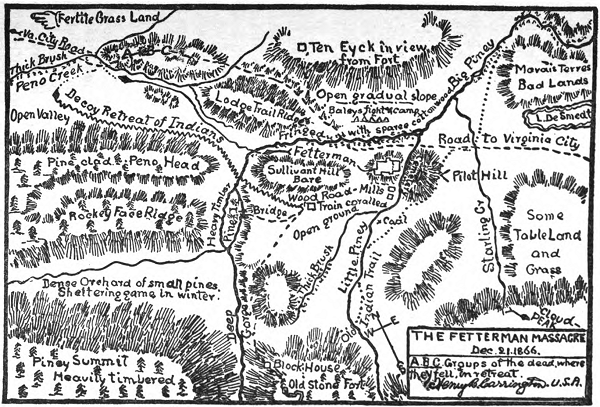
Area Of Action
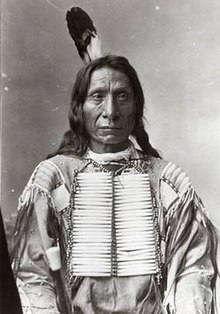
Red Cloud
The Death Of John Bozeman
After negotiations for safe passage are rejected by the Indians at a Fort Laramie council (annual cash and supply bribes fail), protect the travelers with soldiers, becomes protect the protecting soldiers with forts ... and so it is that Colonel Henry B. Carrington is given orders to build three forts along the trail, one at its beginning (Fort Reno, named for Major General Jesse Lee Reno, killed at the 1862 Battle of South Mountain ... the fort already exists, but Carrington puts in upgrades to the walls and weaponry), one in a centralized location (Fort Phil Kearny, named for Major General Phil Kearny, killed at the 1862 Battle of Chantilly), and one at the trail's end (Fort C. F. Smith, named for Major General Charles Ferguson Smith, who dies in 1862 from a foot injury infection). In June of 1866, Carrington begins his mission with 700 soldiers, 300 civilians (wives, children, and various contractors), 226 wagons filled with supplies, a 35-man regimental band, and 1,000 heads of cattle for fresh meat, all guided by mountain man legend, Jim Bridger. And the trouble begins almost immediately as incensed Indians begin hit-and-run attacks on any targets of opportunity outside the forts.

Carrington
Bridger

Fort Phil Kearny
Forts built (in putting up Fort Phil Kearny, Carrington will lose 6 soldiers, 28 civilians, and numerous stock animals to Indian attacks), the style of warfare the Indians confront the army troops with effectively cuts off each of the forts from each other, and the Bozeman trail shuts down for the duration of the war, with the soldiers not worried about protecting pilgrims along its length, but in simply surviving themselves from day-to-day (a century later, portions of the Vietnam War will mirror the U.S. Army's confrontation with the Indians of Wyoming and Montana) ... and it quickly becomes obvious that Carrington is not the warrior needed for the situation (a scholar and an intellect, the colonel will graduate from Yale, become a professor of natural science and Greek, with the backing of legendary early American author Washington Irving, write a book called "Battles of the American Revolution," get a law degree from Yale and start a practice in Ohio with the future governor of the state, help organize the Republican Party in 1854, and will become Ohio's Judge Advocate General in 1857 ... but during the Civil War, rising to Brigadier General, he does nothing but push papers in a far from the front office) ... turning off his superiors with unending calls for more troops and supplies, and fanning deep animosity among some of his men by refusing to allow them to go off "chasing Indians."
Carrington
Taking up residence at Fort Phil Kearny with his wife, Colonel Carrington finds himself at the epicenter of the troubles ... built stoutly of eight foot high timber walls (over 4,000 logs) on Piney Creek (near present-day Buffalo, Wyoming) where it overlooks the Bozeman Trail, the enclosed compound consists of an area of 17 acres that includes a warehouse, sutler's store, hospital, officers' quarters, barracks, stables, laundry, battery park for the artillery, guardhouse, bandstand, and a fatal flaw ... while its location allows guards to see Indians approaching from hundreds of yards away, the grassy flats surrounding the structure do not contain trees of any kind ... and for wood for building or providing warmth, timber must be sought on forested ridges 5-6 miles away which require logging expeditions ... which are continually attacked by the Indians. Routine becomes sending a lightly armed wagon train out for lumber, the expedition being attacked and the wagons forming a defensive circle, the attack being spotted from a nearby signal hill, sending out reinforcements to the wagons, the Indians fleeing as more soldiers show, and then the wagon train returning safely to the fort ... time after time after time.
Observing Fort Phil Kearny
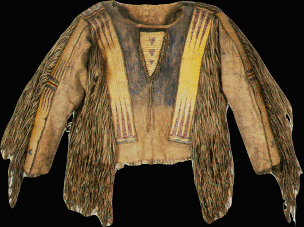
Red Cloud's War Shirt
The routine changes in late November and early December of 1866 however with the arrival of a handful of replacements at the fort, and a change in Indian tactics. Chief among the new residents at the fort is a young firebrand, a veteran of the Civil War who is twice brevetted for battlefield valor and ends the war as a lieutenant colonel (downgraded, like almost everyone else, once the war concludes) ... 33-year-old Captain William Judd Fetterman. Recently victorious over the second best army in the world (Robert E. Lee's Army of Northern Virginia), Fetterman has nothing but disdain for his Indian opponents, telling anyone who will listen that with 80 men he could ride through the entire Sioux nation ... disdain that also enlarges enough to include his commander, Colonel Carrington for his lack of fighting credentials and absence of aggression in dealing with the primitives blocking the trail ... disdain that is soon shared by many of the men in the fort who know that the colonel's superior, General Philip St. George Cooke, has ordered Carrington to take the offensive in putting down the Indians' "murderous and insulting attacks" (to which Jim Bridger responds, "These soldiers don't know anything about fighting Indians.").
Fetterman

Cooke
On the Indian side, after another wagon train attack on December 6, it is noticed that the attackers are chased, and then panic, when the fleeing Indians turn and charge their cavalry opponents ... a skirmish in which cavalry commander Second Lt. Horatio S. Bingham is killed. Wanting something similar on a grander scale, the Indians plan an ambush of the next command to "chase" them, but are thwarted, when Captain James Powell follows orders, stays with the latest rescued wagons, and returns them, and their vital cargo of timber, safely back to the fort. Storm signs in the air and Christmas just around the corner, Carrington sends out another wagon train on December 21st, and when it is attacked at about 10:00 in the morning, Powell is once more given the duty of going to its assistance ... but then, God, Fate, or Karma step in!

Bingham
Stepping forward, wanting a piece of the action, Fetterman demands based on seniority of rank, to be given the command of the rescue party ... and Carrington, not wanting to create more problems within his command, foolishly acquiesces ... but with a major caveat ... knowing the kind of officer he is dealing with, three times in front of witnesses, the colonel orders the captain "under no circumstances" to pursue any Indians over Lodge Ridge Trail, north of the fort. "Yes, Sir!" Fetterman salutes, and then leaves on his mission with 49 soldiers of the 18th Infantry (carrying single-shot, muzzle loading Civil War rifles), armed with 7-shot Spencer rifles, 27 mounted troopers of the 2nd Cavalry led by Lt. George W. Grummond (another vocal critic of the colonel), post quartermaster and Carrington critic, Captain Frederick Brown, 18th Regiment armorer, Private Maddeon, and two civilian scouts armed with state-of-the-art, 16-shot Henry repeating rifles, James Wheatley and Isaac Fisher ... 80 men to the nose, exactly the quantity Fetterman has stated he would need to ride through the whole Sioux nation.
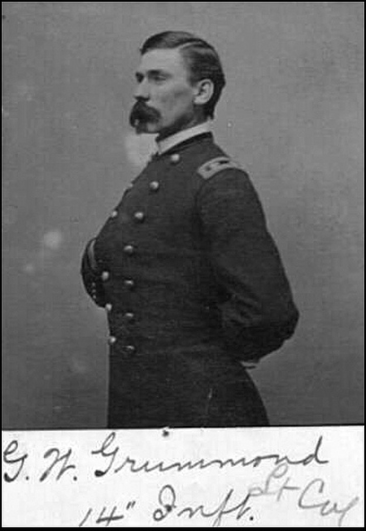
Grummond
Almost instantly showing he will disregard Carrington's orders, once outside the fort, instead of heading directly for the wagon train, Fetterman takes a route to the northwest that will put him behind the attacking Indians (by this time, it is reported that the wood cutters are no longer under attack) ... and as Carrington, wanting to display his fighting spirit, is distracted by personally positioning a cannon and then firing it at a group of warriors approaching the fort, his command drops out of sight, over the far side Lodge Ridge, and into disaster.
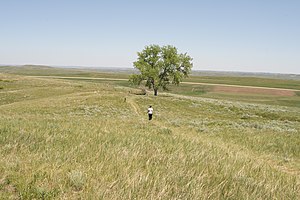
Present Day Site - Now Known As Massacre Hill
Greeted by a handful of taunting Indians (genitals and butts are displayed) dancing in the valley below (led by Crazy Horse, Red Cloud does not participate in the actual fighting), Grummond's horsemen charge forward, with Fetterman and the infantry following as closely as they can ... then, after a half mile chase, the Indian decoy riders break left and right, giving the signal to attack, and between 1,000 to 2,000 warriors rise up from the tall grasses and shrubs filling a flat area around Peno Creek (Arapaho and Cheyenne on one side, and members of the Brule, Oglala, and Minniconjou tribes of the Sioux nation) and fall on Fetterman's command with arrows (it is estimated that over 40,000 will be fired during the encounter), lances, clubs, and knives (only a handful of Indians are armed with guns, and only eight soldiers will afterwards identified as having perished from gunfire).
The Fetterman Fight
First to go, leading all riders in the chase, is Grummond, who is killed after decapitating a decoy with his saber, then the rest of the horsemen are swarmed, before Fetterman and the infantry get their turn being butchered ... 80 men gone in somewhere between 20 to 40 minutes of time (the Indians are said to have lost somewhere between 20 to 40 warriors) ... and much like what will happen at Custer's Last Stand, the only survivor on the army side will be a badly wounded horse, a grey cavalry mount named Dapple Dave. Disaster instigator and his best buddy, it will be reported that Fetterman and Brown fight until almost the end, then with their last bullets, shoot each other in the head, but upon evaluation after the battle, Fetterman is found with his throat slashed, and his brain bullet-less (his death credited to the Sioux warrior, American Horse). And as is their style of war, to prevent meeting up with their victims in the after life, all the bodies, save one, are grossly mutilated and the valley is transformed into an abattoir of chopped off genitals, lips, scalps, fingers, hands, noses, teeth, brains, eyes, feet, and pools of frozen blood. Receiving special savage treatment due to the number of Indians they slay with their repeaters, Wheatley and Fisher have their faces pounded into crimson mush, and Wheatley's body is found pierced by 105 arrows!
Massacre
Massacre
The only dead soldier to remain whole is also said to be the last of Fetterman's command to die ... 32-year-old bugler, Adolph Metzger of Balingen, Germany. Fighting until his ammunition runs out, Metzger goes Samson on the Indians (though he is only 5'5"), using his bugle as a bludgeon to keep his attackers at bay, and bash in the brains of at least three tormentors until he is finally brought down. Honoring a fellow warrior, the Indians will not molest Metzger's body, and will instead, cover it with a fine, buffalo robe.
Metzger
Call To Rally

The Pulped Bugle
Reacting to the disappearance of Fetterman and his men, and the sound of gunfire from the other side of the ridge, a little after noon, Carrington sends out Captain Tenedor Ten Eyck and 54 soldiers to find out what has befallen the missing men (though everyone in the fort can quite correctly guess), ordering him to retreat at the first sign of any troubles (80 or so men in the original wood train, 80 with Fetterman, and then the Ten Eyck force almost empties the 300 man fort of protection, but the Indians have no attack plans for the day beyond ambushing anyone coming to the wood cutters rescue). Arriving on the ridge at a spot where he can look down into the valley, the relief column discovers the valley covered in hundreds of dancing Indians (and what appear to be numerous naked white bodies laying on the ground) ... who immediately begin taunting the soldiers to come down and fight. Wisely ignoring the challenges, Ten Eyck remains on the ridge until the valley empties of Indians, and then takes his force into the heart of the tragedy and begins collecting frozen bodies, before returning to the fort before night completely falls (the identified victims of the battle now reside at the Little Bighorn Battlefield National Cemetery). Aware of the magnitude of the tragedy, and the on going jeopardy his command is in, Carrington asks for a volunteer to ride through hostile territory, and a now begun blizzard, 236 miles to Fort Laramie to request immediate reinforcements ... and the last story of that long December 21st begins.
Ten Eyck
As if out of a Hollywood script, a civilian named John "Portugee" Phillips volunteers and is given Carrington's mount to ride. Off into the wind, snow, and sub-zero temperatures, it take Phillips four days to reach Fort Laramie, arriving exhausted, covered in snow and ice, just as the officer's Christmas Dance is getting into full swing, collapsing on the ballroom floor as he gives news of the massacre (barely surviving his ordeal, Phillips will be in a sick bed for weeks ... while Carrington's horse collapses and dies the next day). The fort's response is immediate ... sending men and supplies north, including a replacement for Carrington, Brigadier General Henry W. Wessells (one man of the command will freeze to death on the march to the fort). Scapegoat needed to explain the disaster, the army at first chooses Carrington, wanting his court martial (at the highest levels, President Grant and General William T. Sherman), but settling on Fetterman when a court of inquiry exonerates the colonel (officially not guilty of any misconduct, the public will not be as forgiving, egged on by the additional fact that Carrington marries Captain Grummond's widow after his first wife dies in 1870, and he will spend the rest of his life deflecting criticism on to his subordinate, Fetterman).
Memorial
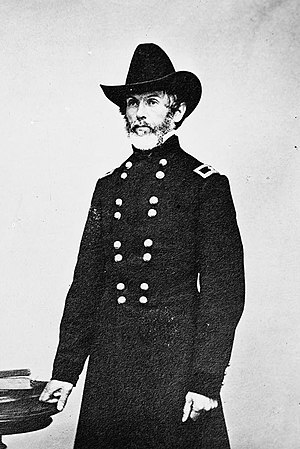
Wessells
No more successful than Carrington, Wessells and other commanders will struggle through two more years of skirmishing with the Indians along the Bozeman Trail, two of which will be deemed worthy of being named, the Hayfield Fight and the Wagon Box Fight, before a peace of sorts is finally reached with the 1868 Treaty of Fort Laramie which creates a Great Sioux Reservation, an area that includes the Black Hills and all of South Dakota west of the Missouri River, and declares the Powder River area of the Bozeman Trail to be "unceded Indian territory," a reserve for Indians choosing not to live on the new Sioux reservation, and hunting reserve for the Arapaho, Cheyenne, and Sioux peoples ... Red Cloud has won his war (though it will only last until 1876, and the next Indian war which results in Custer's Last Stand), and in celebration, his warriors burn down the three offending forts (Fort Phil Kearny has since been rebuilt as a national historic site).
Wagon Box Fight
The Burning of Fort Phil Kearny
Victory
12/21/1866 ... why today mattered ... Captain Fetterman and his command of 80 men DO NOT ride through the entire Sioux nation!
Reconstructed Fort Phil Kearny Wall
Massacre Site And Memorial
Memorial

Grave
Massacre - Modern Interpretation
No comments:
Post a Comment